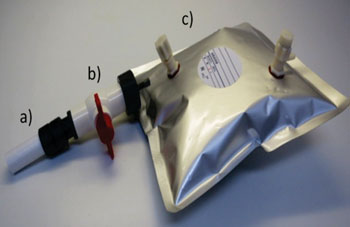Malaria Biomarkers Detected In Human Breath
By LabMedica International staff writers
Posted on 14 Apr 2015
The majority of diagnoses of malaria rely on a combination of clinical presentation and visualizing parasites in a stained blood film or by performing a rapid diagnostic test.Posted on 14 Apr 2015
Human breath offers an attractive alternative to blood as the basis for simple, non-invasive diagnosis of infectious disease, and when breath samples were taken during controlled human malaria infection specific malaria associated volatiles could be detected in human breath.

Image: Cardboard mouthpiece (a), chamber with red valve (b) and 3-L impermeable gas bag (c) used to collect breath samples (Photo courtesy of the Commonwealth Scientific and Industrial Research Organization).
Scientists at the Commonwealth Scientific and Industrial Research Organization (CSIRO) (Dickson, Australia) and their colleagues collected breath samples from volunteers that had been infected with the malaria parasite Plasmodium falciparum, who were enrolled in a drug trial. The volunteers breathed through a cardboard tube into a chamber connected to a connected to a 3‐L impermeable aluminum gas bag (Shanghai Sunrise Instrument Co.; Shanghai, China).
Exhaled breath analysis was carried out by gas chromatography-mass spectrometry. The gas chromatograph 451 Model GC (Bruker Daltonik Inc.; Billerica, MA, USA) was used and the Bruker Daltonik Scion SQ single quadrupole mass was set with a full scan detection. Real-time polymerase chain reactions and cell cultures were also performed.
The team identified nine compounds whose concentrations varied significantly over the course of malaria infection: carbon dioxide, isoprene, acetone, benzene, cyclohexanone and four thioethers. The latter group: allyl methyl sulfide, 1-methylthio-propane, (Z)-1-methylthio-1-propene and (E)-1-methylthio-1-propene had not previously been associated with any disease condition.
Before antimalarial-drug treatment, there was evidence of concurrent 48 hour-cyclical changes in both the levels of thioethers and parasitemia. Phase-shifting the values for thioether concentrations by 24 hours, revealed a direct correlation between the parasitemia and volatile levels. Volatile levels declined monotonically at around 6.5 hours after initial drug treatment, correlating with clearance of parasitemia. The study was published online on March 25, 2015, in the Journal of Infectious Diseases.
Related Links:
Commonwealth Scientific and Industrial Research Organization
Shanghai Sunrise Instrument Co.
Bruker Daltonik Inc.












.jpg)
